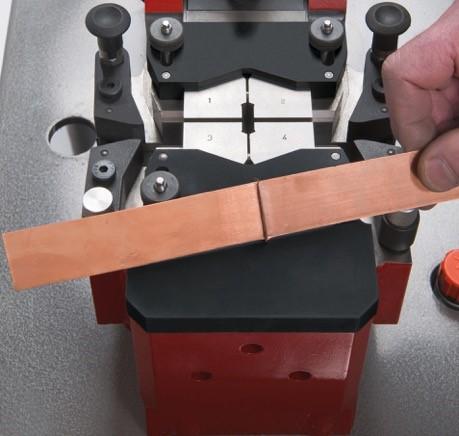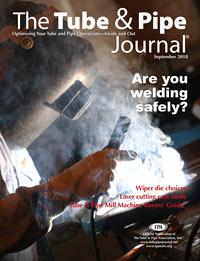- FMA
- The Fabricator
- FABTECH
- Canadian Metalworking
Categories
- Additive Manufacturing
- Aluminum Welding
- Arc Welding
- Assembly and Joining
- Automation and Robotics
- Bending and Forming
- Consumables
- Cutting and Weld Prep
- Electric Vehicles
- En Español
- Finishing
- Hydroforming
- Laser Cutting
- Laser Welding
- Machining
- Manufacturing Software
- Materials Handling
- Metals/Materials
- Oxyfuel Cutting
- Plasma Cutting
- Power Tools
- Punching and Other Holemaking
- Roll Forming
- Safety
- Sawing
- Shearing
- Shop Management
- Testing and Measuring
- Tube and Pipe Fabrication
- Tube and Pipe Production
- Waterjet Cutting
Industry Directory
Webcasts
Podcasts
FAB 40
Advertise
Subscribe
Account Login
Search
Custom cold-welding power supply streamlines tube production
- August 22, 2018
- Article
- Tube and Pipe Production
Situation
Tube manufacturer Virtus Precision Tube, Franklin, Ky., is no stranger to the ups and downs of the heating, ventilation, and air conditioning market, nor its cousin, the refrigeration market. Product demand can be volatile, and the price of copper is unforgiving.
“We produce over 40 million pounds of roll-and-weld copper tube each year, in sizes from ¼ in. to ½ in.,” said Joe Napier, Virtus’ engineering program manager.
Air conditioning systems manufacturers saw their market shrink by nearly 50 percent from 2005 to 2010, decreasing from 6.47 million units to 3.42 million units, according to data compiler Statista. The market then recovered and regained most of the ground it had lost; in 2017 U.S. manufacturers shipped 5.19 million units. And while copper prices aren’t as high as they once were, they’re still steep. According to macrotrends.com, the price was a little more than $3 per pound ($6,000 per ton) throughout much of 2017.
Needless to say, Virtus continuously looks for ways to do things more efficiently and to upgrade and improve the way it makes copper tubing.
Resolution
A cold-welding system developed by Pressure Welding Machines (PWM) Ltd., Kent, England, in partnership with Virtus, has streamlined and improved the process by which Virtus produces copper tube. Using customized version of PWM’s model ST40 has improved uptime, reduced costs, and created a better working environment for operators, according to Napier.
“The cold-welding system we developed with PWM is part of our continuous improvement program,” Napier said. “It supports our on-going drive to develop high-performance tubing solutions for the HVAC and refrigeration heat exchanger markets.”
The cold-welding process joins nonferrous materials without heat, flux, or fillers to produce welds that are stronger than the parent material. The ST40 doesn't require setup time, according to the company: The operator simply loads the two ends of the strip into either side of the die and presses the foot pedal to operate the machine. Each time the machine is activated, the two ends of the strip are gripped by the die and fed forward. As the two ends are pushed against each other, the oxides and other surface impurities are pushed out from the core of the metal, and the two clean surfaces bond.
The ST40 handles copper strip up to a maximum width of 1.772 in. and a minimum thickness of 0.00787 in., depending on material properties, and provides a process that is faster, more versatile, and produces better welds than its predecessor, according to Virtus.
“PWM partnered with us to demonstrate the durability, reliability, and ease-of-use of the process using a portable ST40 cold pressure welding machine on loan,” Napier said. "PWM then helped us develop a full operator work station, capable of keeping pace with our production demands. A six-month trial of the system in production enabled us to reduce the scrap rate by about 15 percent on the line.”
PWM has now supplied Virtus with seven of the welding machines, which run full-time in production. Adaptations such as automatic flash trimming and annealing, and automation of the weld cycle and die opening system, have helped to further streamline the process.
Pressure Welding Machines Ltd., www.coldpressurewelding.com
About the Publication
Related Companies
subscribe now

The Tube and Pipe Journal became the first magazine dedicated to serving the metal tube and pipe industry in 1990. Today, it remains the only North American publication devoted to this industry, and it has become the most trusted source of information for tube and pipe professionals.
start your free subscription- Stay connected from anywhere

Easily access valuable industry resources now with full access to the digital edition of The Fabricator.

Easily access valuable industry resources now with full access to the digital edition of The Welder.

Easily access valuable industry resources now with full access to the digital edition of The Tube and Pipe Journal.
- Podcasting
- Podcast:
- The Fabricator Podcast
- Published:
- 04/30/2024
- Running Time:
- 53:00
Seth Feldman of Iowa-based Wertzbaugher Services joins The Fabricator Podcast to offer his take as a Gen Zer...
- Trending Articles
Zekelman Industries to invest $120 million in Arkansas expansion

3D laser tube cutting system available in 3, 4, or 5 kW

Corrosion-inhibiting coating can be peeled off after use

Brushless copper tubing cutter adjusts to ODs up to 2-1/8 in.

HGG Profiling Equipment names area sales manager

- Industry Events
Pipe and Tube Conference
- May 21 - 22, 2024
- Omaha, NE
World-Class Roll Forming Workshop
- June 5 - 6, 2024
- Louisville, KY
Advanced Laser Application Workshop
- June 25 - 27, 2024
- Novi, MI
Precision Press Brake Certificate Course
- July 31 - August 1, 2024
- Elgin,



























